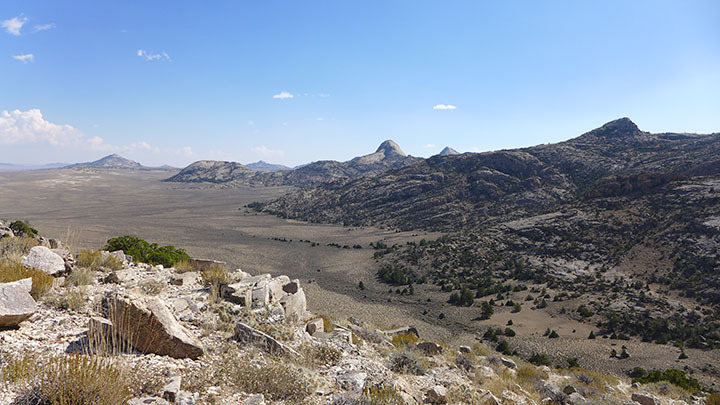NEWS RELEASE: WSGS and USGS Team Up to Study Mineral Resources in Central Wyoming
Wyoming State Geological Survey sent this bulletin at 04/27/2023 02:17 PM MDT
April 27, 2023
******FOR IMMEDIATE RELEASE******
Media Contact:
Christina George
christina.george@wyo.gov
WSGS and USGS Team Up to Study Mineral Resources in Central Wyoming
Scientists from the Wyoming State Geological Survey (WSGS) and the U.S. Geological Survey (USGS) have launched a collaborative effort to collect a large swath of geophysical data in central Wyoming to better understand the area’s geologic framework for critical and other essential mineral resources.
The geophysical survey will focus near South Pass at the southern end of the Wind River Range and on the Granite Mountains west of Pathfinder Reservoir. The region is known for historic and current mineral exploration, and there are several areas that are of high interest for their mineral potential. This region also has incompletely understood earthquake hazards.
Dr. Erin Campbell, Wyoming State Geologist and Director of the WSGS, noted the importance of regional studies like these.
“This geophysical survey will provide data critical for geologic understanding that will in turn help drive investment in the state for years to come,” says Campbell. “We know this region has a high potential for mineral resources, and are pleased to work with the USGS and their knowledgeable team of geoscientists to provide the best data possible to the state.”
Understanding the geology of Wyoming in places that may contain mineral resources is a key step in securing a reliable and sustainable supply of minerals that are essential to modern society, including powering everything from household appliances and electronics to clean energy technologies like batteries and wind turbines.
“I’m looking forward to this project because the magnetic and radiometric data collected on this airborne survey will improve our understanding of the region’s geologic history, its mineral potential, and its earthquake-related hazards,” says USGS scientist Dr. Ben Drenth, the USGS lead researcher on this survey.
The survey will collect a combination of magnetic and radiometric data from a helicopter, with information retrieved from up to several miles below the surface. Magnetic data can be used to identify ancient faults, compositional differences in adjacent rocks, and other geologic features. The radiometric data indicate the relative amounts of potassium, uranium, and thorium in shallow rocks and soil.
These types of geophysical investigations are an efficient way to detect anomalous rocks and trends to help understand the geology and mineral resources for the region. The data also provide valuable information for energy and groundwater resources as well as potential geologic hazards.
The mineral systems of interest in the survey area include alkalic porphyry, mafic magmatic, magmatic rare earth elements, metamorphic graphite, meteoric convection, orogenic gold, porphyry copper-molybdenum-gold, and volcanogenic seafloor.
Potential critical mineral commodities include aluminum, antimony, arsenic, barium, beryllium, bismuth, chromium, cobalt, fluorspar, gallium, germanium, graphite, hafnium, indium, manganese, niobium, nickel, platinum group elements, rare earth elements, scandium, tantalum, tellurium, tin, titanium, tungsten, vanadium, zinc, and zirconium.
There is additional potential for cadmium, copper, gold, iron, lead, mercury, molybdenum, phosphorus, selenium, silver, thorium, and yttrium.
The initial airborne geophysical survey will be followed by continued research, including new geologic mapping and other interpretive techniques to study the geology and mineral resource potential of the region.
“The collaboration between the WSGS and USGS will significantly enhance the national dataset and the understanding of mineral systems throughout the country,” says Dr. Warren Day, Science Coordinator for the USGS Earth Mapping Resources Initiative (Earth MRI). “The data will be reviewed for quality assurance by the USGS and made publicly available through the USGS and WSGS.”
Earth MRI is a partnership between the USGS and state geological surveys across America to modernize our understanding of the Nation’s fundamental geologic framework and knowledge of mineral resources. The USGS Earth MRI program is funding two other large aerial geophysical surveys in Wyoming, in both the Sierra Madre and Medicine Bow Mountains. For more information on these surveys, as well as other Earth MRI projects in Wyoming and throughout the country, visit the Earth MRI Acquisitions Viewer.
For more information on ongoing WSGS minerals-related projects, see the WSGS current projects website. For more information on USGS mineral research, see the USGS Mineral Resources Program website or follow the USGS on Twitter.

Caption: Granite Mountains in central Wyoming. Lone Mountain is at the far left, Lankin Dome is right of center, and Moonstone Peak is immediately to the right of Lankin Dome. (WSGS photo)


